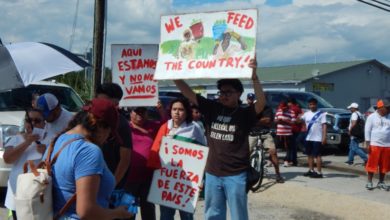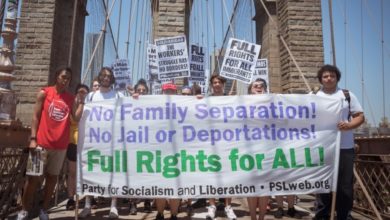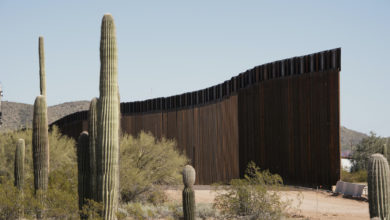In March, millions of people marched through the streets of Los Angeles, Chicago, Washington, Dallas and other cities demanding an end to attacks on and the criminalization of undocumented immigrants. These demonstrations surprised friends and foes alike in their size and militancy. The protest in Chicago on March 10 of 500,000 immigrants was followed by a massive march of over 1 million in Los Angeles on March 25.
After the Los Angeles protest, tens of thousands of middle and high school students walked out of classes in Southern California and all over the country. More than 40,000 students staged walkouts in Los Angeles on March 27 alone. These were the largest walkouts in the nation’s history, evoking memories of the massive 1968 Chicano-led student walkouts in East Los Angeles. Thousands of students occupied the Los Angeles City Hall lawn, waving banners and flags, defying police orders and chanting militantly for full equality and against racism.
In subsequent weeks, large protests happened in hundreds of cities and towns across the country, culminating on April 910, when almost 2 million people marched for immigrant rights in a coordinated day of action, including more than 500,000 in Dallas and hundreds of thousands in New York and Washington, D.C. On April 15 in Los Angeles, tens of thousands of students and community supporters took to the streets to demand amnesty and full legalization.
This explosion signaled the beginning of a new and powerful civil and workers’ rights movement, the size and scope of which surprised many, especially the politicians in Washington and the ruling class. People did not expect that the immigrants and undocumented masses in this country, seen as meek and afraid, would stand up in this way and fight back.
Racist Sensenbrenner bill
 Los Angeles, March 25, 2006. Photo: Bill Hackwell |
The rallies were sparked by recent legislation that threatens to criminalize undocumented immigration. The now infamous Sensenbrenner bill—HR 4437 —sponsored by Wisconsin Republican and chairman of the House Judiciary Committee James Sensenbrenner, would automatically categorize all undocumented workers in the United States as felons, subject to imprisonment and deportation. Legal residents would also be at risk, as any previous minor crime would be retroactively relabeled as an “aggravated felony.” It would pour more money into border patrols and police, and authorize local police to enforce federal immigration laws now carried out only by federal agents. The bill would also require all businesses to document employees’ legal status, and there would be felony charges and jail time for undocumented immigrants. If passed, it would impose fines and jail sentences for anyone associated with assisting an undocumented immigrant in the United States.
Under the Sensenbrenner bill, anyone who pays, feeds, houses or knows an undocumented immigrant could also face felony charges and jail time. This would make documented families of undocumented residents liable to face jail simply for being a family member, and threatens to break apart families and the network of support that undocumented immigrants have in this country. Undocumented immigrants are one of the most oppressed and vulnerable sectors of the U.S. working class.
Although the upsurge was touched off by opposition to the Sensenbrenner bill, new, more powerful demands have taken hold among the immigrant community—the demands of amnesty, full legalization and equality for all immigrants. Many of the main organizers of the March 25 mass protest in Los Angeles embraced these demands, and the left wing of the immigrant and workers’ movement has pushed amnesty to the forefront of the national struggle. Amnesty would allow all immigrants legal status permanently. It would mean an immediate and unconditional path to citizenship and legalization for all the 12 million undocumented immigrants in the United States today. This demand, on the lips of millions of protestors in Los Angeles and across the nation, is not even contemplated in the Sensenbrenner bill.
The Sensenbrenner bill passed the House in December. However, to become law, it must pass through the Senate and be signed into law by the president. The Senate has produced two other bills on immigration—the Specter bill and the Kennedy-McCain bill.
 Union members join 125,000-strong march in New York, April 10, 2006. Photo: Roberto Mercado |
Senate maneuvering fails
The Specter bill is not quite as draconian as the Sensenbrenner bill, in the sense that it would allow immigrants who entered this country before Jan. 4, 2004, and who have jobs, to participate for up to six years in the temporary worker program. However, it legalizes a permanent underclass of cheap labor that can never hope to become permanent residents. They would be here just temporarily to work for cheap and then be deported once their labor has been used and exhausted.
The so-called “liberal” bill is the Kennedy-McCain bill. It would allow 400,000 foreign workers each year, providing them with three-year visas. Some of these workers would have the opportunity to become permanent residents under certain conditions. They would have to register, pay a $2,000 fee, clear a background check, learn English and pay back taxes. This bill also imposes heavy fines on employers who hire undocumented workers.
So, while there may be, theoretically, a chance of gaining legal status through Kennedy-McCain, clearly none of these bills are meant to help the immigrant community and in fact are meant to ultimately “curb” undocumented immigration. They also do not deal with the most important need of the immigrant community, the issue of amnesty. In fact, they are very clear in saying that amnesty is simply not to be considered.
But feeling the pressure of the growing movement against Sensenbrenner and fearing the growth of a genuine movement demanding amnesty and full legalization for all immigrants, the Senate scrambled to put together a compromise immigration bill before its two-week recess in April. The Senate failed to reach agreement on the bill. The compromise bill contained racist enforcement provisions and a guest-worker program. It also broke up the undocumented into three categories depending on the length of time they have been in the United States.
 San Francisco, April 10, 2006 Photo: Bill Hackwell |
Under the compromise, undocumented immigrants living in the country at least five years would be eligible for legalization; those living in the country for two to five years would be required to leave for processing before obtaining a temporary visa and, later, potential legalization; and the status of undocumented immigrants living in the country less than two years would not change.
The compromise failed to win enough bi-partisan support to advance to an official Senate-floor vote. Its significance lies in the fact that although it was, on balance, a bad bill for immigrant workers, some form of amnesty for over 7 million undocumented immigrants was now being seriously discussed in the halls of the Senate. This shift was undoubtedly caused by the mobilization of millions of immigrant workers in the streets.
Immigrants in the U.S. workforce
So, why is everyone paying so much attention to the issue of immigration at this time? Why is this so important? In order to answer this we should look at where immigrants come from and why people migrate to the United States.
According to a recent report by the Pew Hispanic Center, there are about 12 million undocumented immigrants in the United States. There has been steady growth in the undocumented immigrant population, increasing at the rate of 500,000 people per year since 2000.
Most, or 78 percent, come from Latin America, with 56 percent coming from Mexico alone. There have been large increases in the number of immigrants coming from East and South Asia as well.
 “General amnesty for all!” San Francisco, April 10, 2006 Photo: Bill Hackwell |
It is also interesting to note that two-thirds of the children of undocumented families are U.S. citizens by birth.
When looking at the labor force statistics, undocumented workers are about 5 percent of the U.S. working class. In certain types of jobs, however, undocumented workers make up large segments of that labor force. For example, undocumented workers made up 24 percent of all farm workers, 17 percent of cleaning or janitorial workers, 14 percent of construction workers and 12 percent of food industry workers. When you look at certain categories of work, the impact of undocumented workers is even greater. For example, 36 percent of all insulation workers are undocumented, as well as 27 percent of all butchers and food processing workers. This does not include all of the nannies and house-cleaning workers that go under the radar everyday making life even easier for the wealthy.
Undocumented workers are huge contributors to the labor force in this country. Because the undocumented are paid less than others, they end up contributing heavily to profits across the board. This helps to explain why the ruling class behaves the way it does with immigrants—it tries to marginalize them but can’t live without them.
The capitalists use racism to fan the flames of fear among U.S.-born workers, calling for sealing the borders and dealing harshly with the undocumented. Yet they know that capitalism and the almighty profit motive could not exist without this permanent super-oppressed sector of cheap labor that can be easily exploited without having to adhere to laws, like those requiring payment of minimum wages and health and safety protections.
But the capitalists cannot ignore the increasing number of immigrants coming to the United States. Now, the bourgeoisie feels compelled to control what looks like a mass inflow of workers that are neither shy nor meek, and who bring with them histories of struggle back home and experience in the class battlefield. This is a basic feature of capitalism in its imperialist stage. Lenin already noted this in 1916: “One of the special features of imperialism is the decline in emigration from imperialist countries and the increase in immigration into these countries from the more [economically] backward countries where lower wages are paid.”
 Washington D.C., April 10, 2006. Photo: Caneisha Mills |
Every now and then, certain sectors of the capitalist class turns up the anti-immigrant heat with near-fascist legislation like the Sensenbrenner bill, or supports fascist gangs like the Minutemen, who patrol the streets looking to attack and lynch immigrants based on the color of their skin and their accent. They are also now fond of using the excuse of the so-called terrorist threat to militarize not just the borders but also entire neighborhoods far from the border where there may be a sizable Latin American or Asian population. And they also try to create legal pools of temporary workers who are forced to leave after being super exploited in the United States for a fixed period.
Why capitalists need immigrant labor
No sector of the ruling class really wants to outlaw immigration. There is too much profit to be made. The terror against immigrants is merely one tactic in the overall anti-worker, anti-union ruling class war against working people. As a political trend based on racism, its own hysterical expression takes life as a fascist-like movement.
Capitalists know that having a super-oppressed sector of cheap labor that has difficulty functioning openly, cannot organize openly and cannot demand better wages and better conditions openly, keeps wages low for all workers. If employers can pay undocumented workers a fraction of what they pay documented workers, all workers will be forced to work for less in order to compete.
The propaganda fed to Black and white workers, for example, that immigrant workers are stealing their jobs is meant to divide the working class and pit sections of it against each other. These false notions help the capitalists conceal the fact that divided workers earn less and have less power, but united, we can fight the boss and the system. This is why capitalists must use a combination of fear and terror along with “bracero,” or temporary worker arrangements, as a way to both marginalize and limit the impact of the undocumented sector of the U.S. working class.
This is also why the capitalists and their political operatives will never call for full amnesty in any of these bills unless they are forced to do so by a powerful, united workers’ movement. General amnesty would make it possible for these workers to fully integrate into the working class and would surely bring vitality and a culture of struggle back into the labor movement. This is a basic democratic demand.
A mass workers’ movement
 New York, March 25, 2006. Photo: Roberto Mercado |
The capitalists and their administrators understand that capitalism needs immigrant labor. They actively seek and demand the “free” flow of capital across borders and around the world. They call it the “free market.” But if capital can travel anywhere and flow freely from nation to nation, breaking down borders, why can’t labor? Why should the outflow of capital be “free” and the inflow of labor be criminalized? As long as there is capitalist expansion, there will be migration and internationalization of labor. It is inevitable.
The struggle to win rights for the most oppressed, the undocumented workers and their families is integral to the struggle of the U.S. working class as a whole. A primary goal of our collective struggle is to build unity and a fight back against capitalist exploitation. The May 1 National Boycott for Immigrant Rights is a step toward this goal. On May 1, millions of immigrants and supporters are refusing to go to work and school and refusing to buy or sell anything in a show of economic and political force. Instead, people are taking to the streets in cities and towns across the nation.
Right now, millions of workers are in motion. Just like the Civil Rights movement of the 1950s and 1960s and the national liberation movements in the 1960s and 1970s, the struggle for immigrant rights could have a lasting impact on the condition of the labor movement in this country. Its militancy and its fight for basic democratic and civil rights could radicalize and inject new life into the struggle for workers rights. Socialists and revolutionaries are working hard with immigrant rights and progressive organizations to forward this goal.






